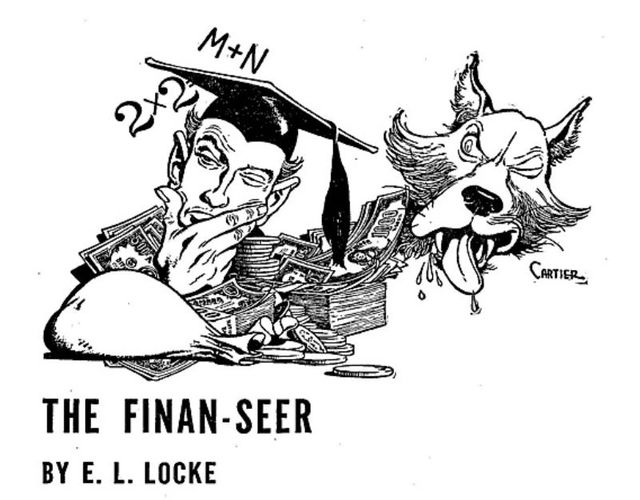-
Vijay Fafat
- Published on
I have to admit that this particular story blew me away for multiple reasons. It is one of the most mathematical of tales ever to appear in pulp magazines, and pound-for-pound in terms of length (so to speak), it gives a run for the money to many recent mathfiction tales. The writing is crisp, with biting sarcasm which applies surprisingly well to this day, as related to economists, mathematicians and Wall Street professionals. And the title of the story itself is a delightful spelling pun. The Trustees of Trent University were convinced by “Wall Street Wolves” that the university’s endowment fund should be invested not just in safe fixed income securities but also in the stock market. Things were initially all chirpy-happy but then, the markets took a decisive turn and now the university finances are in dire straits. In particular, the mess was partly the fault of their own Economics department, which had “analyzed the past performance of the market by applying the theory of Fourier Series, and then extrapolated the result.”, with rather unfortunate results… In desperation, the Trustees wondered whether the esteemed professors of the university, the so-called “Long Hairs”, could help with their “profound thoughts”. Of course they can! A wise mathematician, Newcombe, gets into a back and forth with a JP Morgan-like figure from the Economics department:
“I must say that T am disappointed that my friends in Economics thought that Fourier Series were appropriate to this sort of problem. 1 had the impression that Economics was not an exact science and that the mathematical, techniques used were rudimentary, but it does shock me a bit that they were that naive.” The mathematician had addressed his remarks to Professor Johnsrud of Economics.
“Newcomb, I believe that someone, a mathematician no doubt, once claimed that God must have been a mathematician. You mathematicians have never forgotten that. Let me remind you that the converse of that proposition is not true.”
“My dear Johnsrud, I did not intend to hurt your feelings. It does seem to me that you might at least have used the Theory of Stationary Time Series. In the last war the theory was well developed in connection with the problem of predicting the future position of enemy aircraft, when the data on its present position was distorted by extraneous disturbances. […]. I want to add that since then we have acquired an even more potent attack on just such problems. I am referring to the book by Morgenstern and von Neumann, “Theory of Games and Economic Behavior”. It seems to me that we should exploit the possibilities of this viewpoint.”
From there, the story dives deep into an exposition of Game Theory, probabilities, expectation values and decision-making matrices before resurfacing to show how the Professors use the university’s new computers and the new-found discipline of Game Theory to successfully take on Wall Street (were the world so simple!). The author devotes a couple of pages to explain Game Theory, including a toy example of a two-player, 3-by-3 payoff grid. The explanation of the toy example is very good and its translation into a stock-market problem, though glossed over, seems plausible (esp. in 1949). In the first round, even as newspapers declare that the professors would be slaughtered by the “Wolves”, the professors start making an average gain of 200,000 dollars a day.
After a while, Prof Johnsrud starts getting nervous because his autocorrelation analysis indicates their streak is about to break massively. But Newcombe retains unshakeable faith in his models… and as we have seen repeatedly, this faith gets crushed by the market. Round 2 is lost to Wall Street…
That is when Mr. James, professor of Physics, realizes from a quantum mechanical perspective that their operations had become too big for the markets and they could no longer ignore the back-reaction, harking back to the original (incorrect) explanation of the Heisenberg Uncertainty Principle… when this is corrected for, Round 3 is won by the professors handily.
But by then, they also come to a sage realization that they must stop. As it always happens, their success is getting copied, a race for faster computer and program trading is on, and it is best to go back to the ivory towers…
I found it remarkable that the author took the trouble to explain that at one point, the strategy starts losing money as the market wises up and starts using the same counter-techniques - a hallmark of the “Efficient Markets” theory popularized after the 70s. There is speculation at the end of the story about how game theory deployed with high-tech surveillance methods can be used to win at the casino, again a nice touch. There is a final implicit challenge to the reader to figure out one particular feature of the 3-by-3 grid example.
The story comes across as a cavalier romp but aside from the simplification necessary to fit the story in a few pages, is very cleanly done. A delightful tale and a great example of mathfiction.
